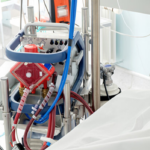The Bubble Test in echocardiography (contrast echocardiography) is a diagnostic test used to assess for intracardiac or intrapulmonary shunting, such as in conditions like patent foramen ovale (PFO) or arteriovenous malformations (AVMs). It involves the injection of microbubble contrast (e.g., agitated saline) into a vein while performing a transthoracic or transesophageal echocardiogram.
Procedure:
1. Contrast preparation:
Agitated saline is prepared by mixing saline vigorously
2. Injection:
The microbubble solution is injected into a peripheral vein, usually during echocardiographic imaging.
3. Observation:
During the echocardiogram, the bubbles are observed as they travel to the right atrium and ventricle.
Normally, bubbles should be filtered by the lungs and not appear in the left heart.
If bubbles appear in the left atrium/ventricle, this suggests an abnormal connection.
Interpretation:
No bubbles in the left heart: Normal, indicating no shunt or an effectively filtered pulmonary circulation.
Immediate bubbles in the left heart (within 1–3 beats): Suggests a right-to-left intracardiac shunt (e.g., PFO, ASD).
Delayed bubbles in the left heart (after 3–5 beats): Indicates a pulmonary AV malformation or shunting at the pulmonary level.
Applications:
Detection of PFO/ASD (common in stroke workups for cryptogenic stroke).
Evaluation of pulmonary AVMs.
Assessment of right-to-left shunting in various cardiopulmonary disorders.
The test may also be combined with maneuvers like a Valsalva to increase intrathoracic pressure and enhance detection of shunts.
Dr Amit Choudhary Critical Care Physician Expert In Pune > Uncategorized > Bubble Test in Echocardiography




